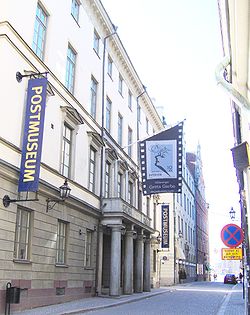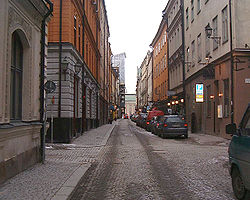
Lilla Nygatan
Encyclopedia


Street
A street is a paved public thoroughfare in a built environment. It is a public parcel of land adjoining buildings in an urban context, on which people may freely assemble, interact, and move about. A street can be as simple as a level patch of dirt, but is more often paved with a hard, durable...
in Gamla stan
Gamla stan
Gamla stan , until 1980 officially Staden mellan broarna , is the old town of Stockholm, Sweden. Gamla stan consists primarily of the island Stadsholmen. The surrounding islets Riddarholmen, Helgeandsholmen, and Strömsborg are officially part of, but not colloquially included in, Gamla stan...
, the old town of Stockholm
Stockholm
Stockholm is the capital and the largest city of Sweden and constitutes the most populated urban area in Scandinavia. Stockholm is the most populous city in Sweden, with a population of 851,155 in the municipality , 1.37 million in the urban area , and around 2.1 million in the metropolitan area...
, Sweden
Sweden
Sweden , officially the Kingdom of Sweden , is a Nordic country on the Scandinavian Peninsula in Northern Europe. Sweden borders with Norway and Finland and is connected to Denmark by a bridge-tunnel across the Öresund....
. Stretching from the square Munkbron
Munkbron
Munkbron is a public square on the western waterfront of Gamla stan, the old town in central Stockholm, Sweden. Connected to the square are Stora Gråmunkegränd, Gåsgränd, Lilla Nygatan, Yxsmedsgränd, and Munkbrogatan; while the traffic route Munkbroleden separates it from the canal...
south to Kornhamnstorg
Kornhamnstorg
Kornhamnstorg is a public square in Gamla stan, the old town in central Stockholm, Sweden.Old names : Kornhaffn , Jernboen , Åkaretorget , Kornhampns torget...
, the street in intercepted by Yxsmedsgränd
Yxsmedsgränd
Yxsmedsgränd is an alley in Gamla stan, the old town in central Stockholm, Sweden.Stretching south from Västerlånggatan to Stora Nygatan, it forms a parallel street to Didrik Ficks Gränd and Kåkbrinken and is crossed by Lilla Nygatan and Munkbrogatan.Throughout its history it appears under various...
, Kåkbrinken
Kåkbrinken
Kåkbrinken is a street in Gamla stan, the old town of Stockholm, Sweden. Stretching from the western waterfront Munkbroleden to the central square Stortorget, it forms a parallel street to Yxsmedsgränd, Solgränd, and Bedoirsgränd, while being crossed by Munkbrogatan, Lilla Nygatan, Stora Nygatan,...
, Schönfeldts Gränd
Schönfeldts Gränd
Schönfeldts Gränd is an alley in Gamla stan, the old town in central Stockholm, Sweden. Stretching south-west from Stora Nygatan to Mälartorget it is crossed by Lilla Nygatan and Munkbrogatan, and forms a parallel street to Kåkbrinken and Lejonstedts Gränd.Before the street names of the old town...
, Tyska Brinken
Tyska Brinken
Tyska Brinken is a street in Gamla stan, the old town in central Stockholm, Sweden. Extending Kindstugatan passed the German Church down to the square Mälartorget, it is crossed by Skomakargatan, Prästgatan, Västerlånggatan, Stora Nygatan, Lilla Nygatan, and Munkbrogatan, while forming a parallel...
, and Lejonstedts Gränd
Lejonstedts Gränd
Lejonstedts Gränd is an alley in Gamla stan, the old town in central stockholm, Sweden. Stretching from Stora Nygatan to Mälartorget and crossed by Lilla Nygatan, it forms a parallel street to Tyska Brinken and Kornhamnstorg....
, while forming a parallel street to Stora Nygatan
Stora Nygatan
Stora Nygatan is a street in Gamla stan, the old town in central Stockholm, Sweden.Old names : nyegatun , nyia gaatan, den nya Konnungsgatun, stora konungsgatun , den store Nye gatan , Konnungsgatun , Nye gaten, KongsGaten , Kongs- eller stoora Nygatan, stora Kongs- el' Nygatan , Stora...
and Munkbrogatan
Munkbrogatan
Munkbrogatan is a street in the western part of Gamla stan, the old town in central Stockholm, Sweden. Stretching south between Munkbron and Mälartorget squares, it forms a parallel street to Munkbroleden and Lilla Nygatan, crossed by Yxsmedsgränd, Kåkbrinken, and Schönfeldts Gränd.Named after...
.
Origin of the name
Together with Stora Nygatan, the street was part of a new city plan following the great fire of 1625, the street probably dating from 1630. It was being referred to as den nedre nye gathen ("the lower new street") in 1639, nedhre Nye gatun in 1641, nedre Nyegathon and nedre gathon in 1646, and Wästere Nyegathun ("western New street") in 1647. In 1660, the street was called Bryggaregatan (Bryggere Gaten, "Brewer's street") because of the number of brewers residing on its western side. Again, it is mentioned as nedrelangathun in 1667, while being called lilla Kongsgatan ("Small King's Street") in the early 18th century. The present name Lilla Nygatan became prevailing from 1720. Because Lilla and Stora Nygatan were often confused with each other, it was suggested in 1921 Lilla Nygatan should be renamed Postiljonsgatan ("Mailcoach Street") in reference to the post office, a proposal never put forward however.History
Archaeological excavations in the crossing Lilla Nygatan/Tyska Brinken in 1993, unveiled remains of an old city wall and traces of what was interpreted as a defensive tower from the 14th century known as Bocktornet ("Buck (He-goat) Tower"). Later investigations have however made in more likely to be structures from the defensive system constructed in the 1560s. The defensive wall passed diagonally across today's Lilla Nygatan; east of the street south of the crossing and west of it north of the crossing.Notable buildings
On Number 6 is the Postmuseum, a postal museum which boasts having a unique postal historical and philatelic collections. The entire block constituted the only post office in the capital from its inauguration in 1720 until the inauguration of the museum in 1906.The present façade, designed by Fredrik Blom in 1820-1825, is centred on the four green Ekeberg marble columns standing on the pavement, the doric
Doric order
The Doric order was one of the three orders or organizational systems of ancient Greek or classical architecture; the other two canonical orders were the Ionic and the Corinthian.-History:...
capitals
Capital (architecture)
In architecture the capital forms the topmost member of a column . It mediates between the column and the load thrusting down upon it, broadening the area of the column's supporting surface...
supporting a balcony decorated with sphinx
Sphinx
A sphinx is a mythical creature with a lion's body and a human head or a cat head.The sphinx, in Greek tradition, has the haunches of a lion, the wings of a great bird, and the face of a woman. She is mythicised as treacherous and merciless...
s. While the windows of the piano nobile
Piano nobile
The piano nobile is the principal floor of a large house, usually built in one of the styles of classical renaissance architecture...
support pediment
Pediment
A pediment is a classical architectural element consisting of the triangular section found above the horizontal structure , typically supported by columns. The gable end of the pediment is surrounded by the cornice moulding...
s with corbel
Corbel
In architecture a corbel is a piece of stone jutting out of a wall to carry any superincumbent weight. A piece of timber projecting in the same way was called a "tassel" or a "bragger". The technique of corbelling, where rows of corbels deeply keyed inside a wall support a projecting wall or...
s, the upper part of the composition is gradually simplified. The interior was rebuilt in 1986, the entire building extensively restored in 1999.

